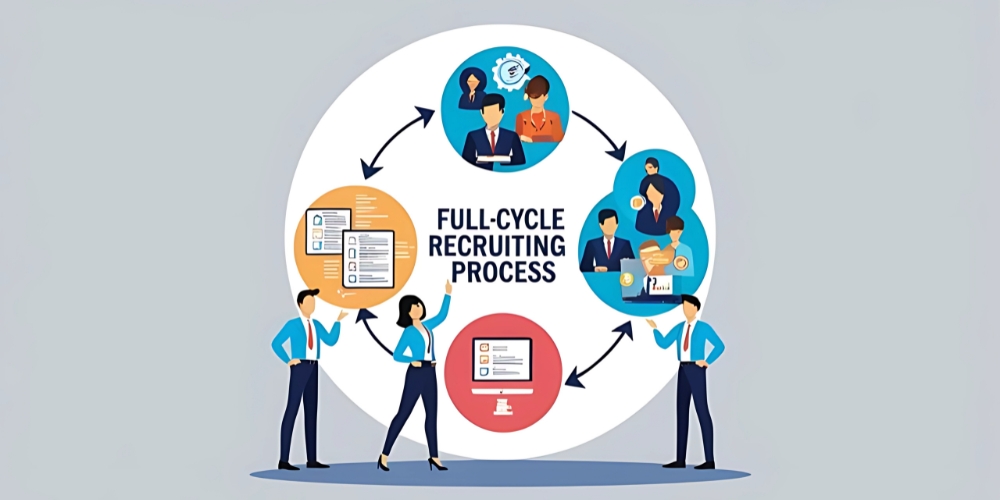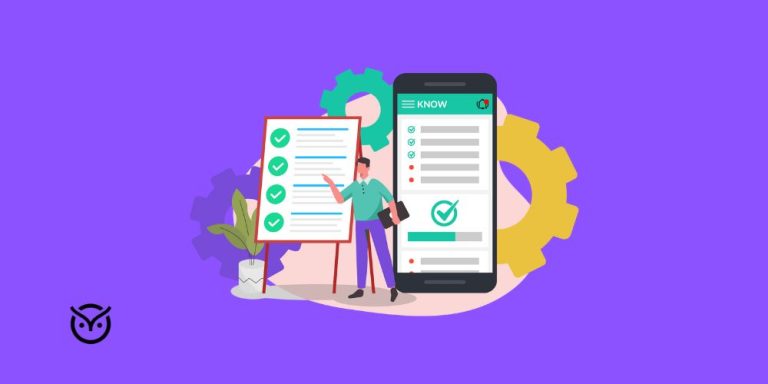Full Cycle Recruiting: The Complete Guide

TL;DR
- One recruiter manages the entire hiring process.
- Six steps: Plan → Source → Screen → Interview → Offer → Onboard.
- Benefits: better candidate experience, faster hiring, higher quality, more accountability.
- Improve with tools, personalization, automation, data, and feedback.
Hiring isn’t just about filling open seats. It’s about building the right team, at the right time, with the right people. But too often, companies treat recruiting like a fragmented relay race, handing off tasks from one department to another. The result? Miscommunication, lost candidates, and a hiring process that feels more like a scramble than a system. That’s why more businesses are shifting to a full cycle recruiting model.
Full cycle recruitment brings structure, accountability, and efficiency by putting the entire recruitment process cycle in the hands of a single recruiter or a small, specialized team. From identifying talent gaps to onboarding new hires, it’s all handled by someone who sees the full picture. This blog will break it all down for you step-by-step, benefit-by-benefit, and shows you how to make cycle hiring work for your business.
What Is Full Cycle Recruiting?

Full cycle recruiting (also known as full life cycle recruiting) is a hiring strategy where one recruiter or recruiting team manages every stage of the recruitment cycle, from start to finish. That means sourcing, screening, interviewing, selecting, offering, and onboarding all under one roof.
Unlike the old-school shuffle where sourcing, interviewing, and onboarding bounce between teams, a full cycle recruiter runs the whole show. That means tighter communication, fewer handoff hiccups, and a candidate experience that actually feels like someone’s paying attention.
Why It Matters
A consistent point of contact improves candidate engagement, and the numbers back it up. According to HBR, organizations with structured recruitment processes see 62% greater new hire productivity than those without standardized systems.
Common Titles
Wondering what is a full cycle recruiter called in the real world? You’ll often see titles like:
- Talent Acquisition Specialist
- Full Cycle Recruiter
- Recruitment Consultant
- Hiring Manager (in lean teams)
Regardless of the title, the responsibility is the same: drive the entire life cycle of recruitment process from vacancy to onboarding.
The Full Life Cycle of Recruitment Process: 6 Key Steps

The recruitment process cycle moves through six clear stages from job opening to onboarding. Here’s a look at how the full cycle recruitment journey typically plays out:
1. Job Planning and Requisition
Every great hire starts here. Align with hiring managers, lock down the must-haves, and write a job description that doesn’t sound like it came from a corporate time machine. This is the foundation of the recruitment cycle. Skip it, and you’ll be fixing problems three steps down the line.
2. Sourcing Candidates
This is where the hunt begins. Whether through job boards, referrals, or proactive outreach, sourcing is about building a pool of qualified applicants. A strong full cycle recruiter knows where to find passive candidates and how to personalize outreach that stands out.
Now it’s time to dig for the gold. Skim the resumes, run quick phone screens, and spot soft skills that actually show up on the job. With structured assessments and smart ATS filters, full cycle recruiting becomes less needle-in-a-haystack and more targeted hit list.
4. Interviewing
This is where things get real. Recruiters line up interviews, loop in the right people, and often sit in to keep things on track. A full cycle recruiter also preps candidates so they show up ready, not rattled. Better prep, better conversations, better hires.
5. Offer and Negotiation
You’ve found your person, now seal the deal. Craft an offer that hits the mark, lines up with expectations, and leaves no room for confusion.
6. Onboarding
Onboarding isn’t tossing over a laptop and disappearing. It’s your moment to prove the new hire didn’t just take a job. They joined the right team. Set clear goals, hand over the tools, and make day one feel like a win, not a warning sign.
Benefits of Full Cycle Recruiting

Switching to a full cycle recruiting model makes hiring easier and better.
1. Improved Candidate Experience
One recruiter, one relationship, one smooth ride. When candidates have a single point of contact through the recruitment process cycle, it builds trust fast. No handoffs. No confusion. Just clarity. And it matters, 66% of candidates say a great hiring experience makes them more likely to say yes, according to CareerPlug.
2. Faster Time-to-Hire
No more bouncing between departments or waiting for handovers. A full cycle recruiter can cut delays by making decisions faster and reducing approval bottlenecks.
3. Higher Quality Hires
With full visibility into each stage, recruiters can fine-tune assessments and interviews for better-fit candidates. This results in higher retention rates and lower first-year turnover, especially when paired with structured onboarding.
4. Increased Accountability
When one person owns the entire life cycle of recruitment process, gaps and drop-offs are easier to spot and fix. There’s less finger-pointing and more responsibility for success.
💡 What’s the biggest benefit of using full cycle recruiting?
Full Cycle Recruiting vs. Traditional Recruiting Models

So, how does full cycle recruiting actually compare to traditional hiring models? Let’s break it down.
| Aspect | Full Cycle Recruiting | Traditional Recruiting Models |
| Ownership | One full cycle recruiter handles everything | Multiple teams handle different stages |
| Candidate Experience | Personalized, consistent communication | Fragmented, with multiple points of contact |
| Speed | Faster due to reduced handoffs | Slower due to dependencies |
| Accountability | Clear, one person owns results | Shared, hard to trace gaps |
| Flexibility | Agile, easy to optimize and adjust | Rigid, harder to adapt on the fly |
Tips to Improve Your Full Cycle Recruiting Process

Want to level up your full cycle recruitment process? Here are practical, proven ways to do it better without breaking the bank.
1. Invest in the Right Tools
Pick an ATS that works for you, not against you. One that keeps things smooth, not messy. If it comes with sourcing, scoring, and interview scheduling built in, even better. The right platform makes the recruitment cycle faster, smarter, and way less chaotic.
2. Personalize Candidate Outreach
Stop sending generic messages. A little personalization goes a long way, especially in cycle hiring, where candidate relationships are everything. Mention mutual connections, highlight specific skills, and always be human.
3. Automate Admin Tasks
Still sending calendar invites by hand? Stop. Let automation handle the follow-ups, scheduling, and tracking. Free your full cycle recruiter from busywork so they can focus on strategy, not spreadsheets.
4. Use Data to Optimize
Track metrics like time-to-fill, source quality, and candidate satisfaction. These insights reveal where your recruitment process cycle shines and where it needs help.
5. Create a Feedback Loop
Ask for feedback after every hire, from candidates and hiring managers. Then act on it. This is how great teams turn good processes into exceptional ones.
💡 What’s one way to speed up full cycle recruiting without sacrificing quality?
Conclusion
The future of hiring is streamlined, human, and smart. Full cycle recruiting fits right into that vision. When one recruiter owns the entire life cycle of recruitment process, hiring becomes more efficient, candidates feel more valued, and teams get built faster. Whether you’re scaling a startup or optimizing enterprise hiring, switching to a full cycle recruitment model gives you the structure of a system and the agility of a relationship-first approach.
🧠 FAQs
See a Jump in Candidate Engagement—Real-Time Strategy in Action
Best practices are nice, but actions get results. Vettio’s real-time strategy tools drive up candidate engagement and cut recruitment cycles —no extra effort required.
Visit Link





